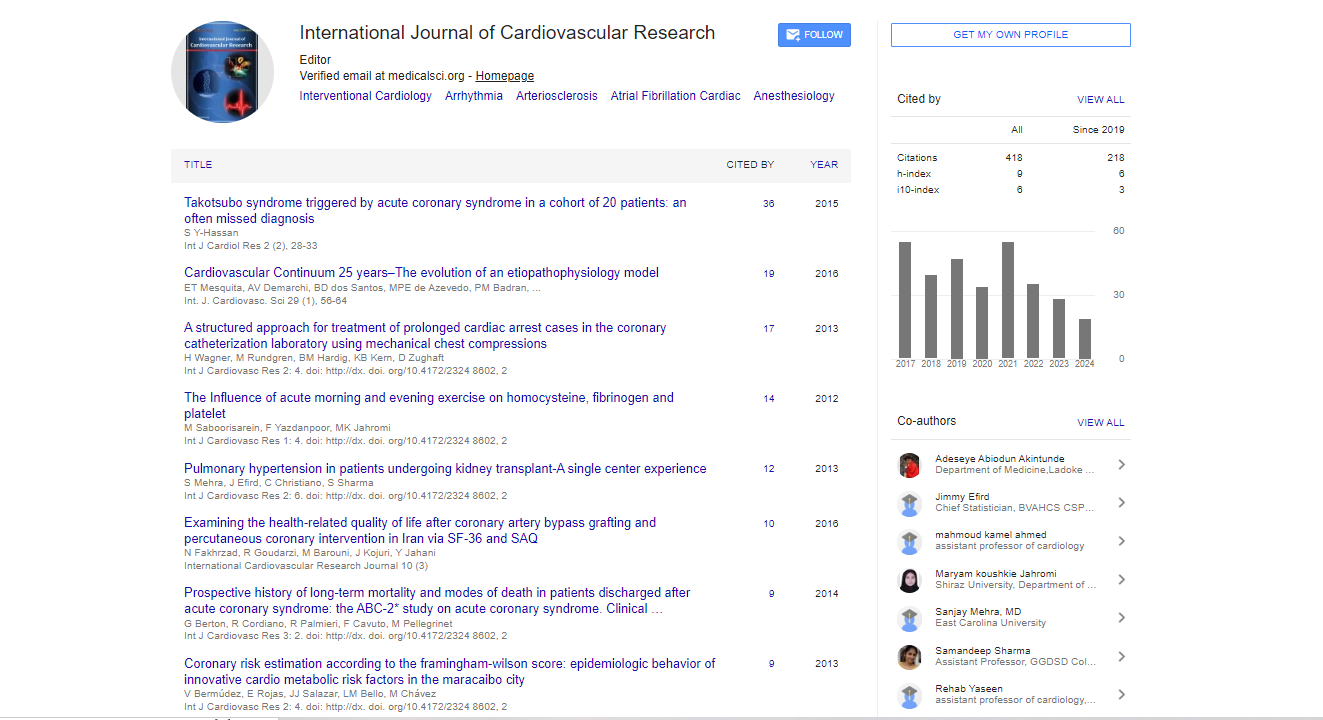Perspective, Int J Cardiol Res Vol: 13 Issue: 6
Advanced Imaging Techniques in the Diagnosis and Monitoring of Atherosclerosis
Leander Ashcroft*
Department of Biochemistry, National University of Singapore, Singapore
- *Corresponding Author:
- Leander Ashcroft
Department of Biochemistry,
National University of Singapore,
Singapore;
E-mail: leander.ashcroft@la.edu.sg
Received date: 07 November, 2023, Manuscript No. ICRJ-23-119407;
Editor assigned date: 09 November, 2023, PreQC No. ICRJ-23-119407 (PQ);
Reviewed date: 23 November, 2023, QC No. ICRJ-23-119407;
Revised date: 16 December, 2024, Manuscript No. ICRJ-23-119407 (R);
Published date: 23 December, 2024, DOI: 10.4172/2324-8602.1000591
Citation: Ashcroft L (2024) Advanced Imaging Techniques in the Diagnosis and Monitoring of Atherosclerosis. J Aging Geriatr Med 13:6.
Introduction
Atherosclerosis is a complex, progressive disease that involves the buildup of fatty deposits, cholesterol, and other substances on the walls of arteries, leading to the narrowing and hardening of these vital blood vessels. It is a major underlying cause of various cardiovascular diseases, such as heart attacks and strokes, which are the leading global causes of morbidity and mortality. Early detection and continuous monitoring of atherosclerosis are essential for effective prevention and management.
Description
Ultrasound imaging
Ultrasound imaging, also known as vascular ultrasound or Doppler ultrasound, is a widely used technique for diagnosing and monitoring atherosclerosis. It is non-invasive, cost-effective, and does not expose the patient to ionizing radiation. High-frequency sound waves are used to build images of blood flow and the structure of blood vessels. By measuring blood flow velocities and detecting plaque deposits, ultrasound can provide valuable information about the extent of atherosclerosis and its impact on blood circulation.
Carotid ultrasound, in particular, is a common application for assessing atherosclerosis in the carotid arteries, which supply blood to the brain. It can help identify plaque buildup and stenosis (narrowing) in these arteries, which are strong indicators of an increased risk of stroke. In addition, Intra-vascular Ultrasound (IVUS) is a specialized technique that allows the assessment of atherosclerotic lesions from within the coronary arteries, providing high-resolution images of plaque morphology and composition.
Computed Tomography (CT) Angiography is another advanced imaging technique used in the diagnosis and monitoring of atherosclerosis. It involves the use of X-ray technology to develop detailed cross-sectional images of the arteries. CT angiography can provide information about the presence, location, and severity of arterial stenosis and the composition of atherosclerotic plaques. The use of contrast agents enhances the visibility of blood vessels, making it particularly useful in visualizing coronary arteries, which are often affected by atherosclerosis.
Coronary CT angiography is a specialized application that can noninvasively assess Coronary Artery Disease (CAD), helping to identify blockages and narrowing in the coronary arteries, which supply blood to the heart muscle. This technology has improved the diagnosis and risk assessment of CAD, reducing the need for invasive procedures like coronary angiography.
Magnetic Resonance Imaging (MRI) is a versatile imaging modality that has been increasingly employed in the diagnosis and monitoring of atherosclerosis. Unlike X-rays, MRI uses powerful magnetic fields and radio waves to form detailed images of the body's internal structures. In the context of atherosclerosis, MRI can provide information about plaque composition, including the presence of lipid-rich, fibrous, or calcified plaques. This information is valuable in assessing the stability of atherosclerotic lesions since certain plaque types are more prone to rupture, leading to acute cardiovascular events.
Moreover, advanced MRI techniques such as Magnetic Resonance Angiography (MRA) can visualize blood flow patterns and the extent of arterial stenosis without the need for contrast agents. Cardiovascular MRI can be used to assess cardiac function and detect signs of ischemia, which can be caused by atherosclerotic narrowing of coronary arteries.
Positron Emission Tomography (PET) often used in conjunction with Computed Tomography (PET-CT), is a nuclear imaging technique that provides valuable information about the metabolic activity of atherosclerotic plaques. By using radiotracers that target specific metabolic processes, PET-CT scan highlight areas of inflammation and plaque vulnerability. Inflammation plays a vital role in the development and progression of atherosclerosis, and identifying its presence can help guide treatment decisions.
Optical Coherence Tomography (OCT) is a high-resolution intravascular imaging technique that utilizes near-infrared light to capture detailed images of coronary arteries and their plaque composition. OCT is particularly useful for identifying thin-cap fibroatheromas, a type of vulnerable plaque that is prone to rupture, potentially leading to heart attacks. This technology is invaluable for guiding interventional procedures, such as percutaneous coronary interventions (angioplasty and stent placement), and for evaluating the success of these procedures.
Conclusion
Advanced imaging techniques have greatly enhanced our ability to diagnose and monitor atherosclerosis, offering detailed insights into its progression and impact on arterial health. These techniques, including ultrasound, CT angiography, MRI, PET, and OCT, have enabled healthcare professionals to assess plaque composition, inflammation, and vascular stenosis with unprecedented precision. This information is vital for risk assessment, treatment planning, and patient management.
As technology continues to evolve, these imaging modalities will likely become even more powerful and accessible, further improving our ability to detect and manage atherosclerosis. Early diagnosis and continuous monitoring of this disease are essential for reducing the burden of cardiovascular disease, ultimately improving the quality of life and extending the lifespan of millions of individuals worldwide.
 Spanish
Spanish  Chinese
Chinese  Russian
Russian  German
German  French
French  Japanese
Japanese  Portuguese
Portuguese  Hindi
Hindi 



